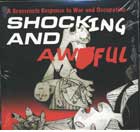
Shocking and Awful; A Grassroots Response to War and Occupation 2006
Distributed by Deep Dish TV, 339 Lafayette St., New York, NY 10012; 212-473-8933
Produced by Persheng Vaziri and Brendan Schwartz
Various directors
DVD, color, 12 programs, 28 min. each
Sr. High - Adult
American Studies, Economics, Human Rights, Middle Eastern Studies, Military Studies, Political Science, Postcolonialism
Date Entered: 02/16/2007
Reviewed by Jane Sloan, Rutgers University LibrariesShocking and Awful is a compilation of half hour programs by independent film makers and activist journalists that focuses on specific themes related to the current Iraq War. The series is generally well edited, often very effectively so, and incorporates good amounts of animated comic material, music, creative overlapping sound and other features which appeal to young adults; it moves along at a good clip even through the most difficult subjects. While not every program can be highly recommended, most contain a concise and clear level of argument. The last six installments have an increased portion of interview material with journalists like Larry Everest, Tariq Ali, and Naomi Klein, and academic experts like Noam Chomsky.
Disc 1 1. The Real Face of Occupation contains interviews with Iraqis on the street, victims’ families, and community organizations, such as those attempting to keep the streets safe. Footage of their encounters with U.S. troops, and troop raids detail the level of tension, despite their dislike of Saddam Hussein. A citizen concludes: “The student has left and the teacher has come. And the people are the victim! That summarizes it!” 2. Standing with the Women of Iraq contains interviews with the Shiite Women’s Circle, as well as U.S. activists like Alice Walker and Kathe Kollowitz, the organizations Women in Black, and footage of demonstrations. 3. National Insecurities focuses on the racist backlash and hate crimes that flourished in the U.S. after September 11 2001, the treatment of detainees, the persecution of pro-Palestinian groups, and the relationship of the current situation to racist national laws of the past like the Chinese Exclusion Act of 1882 and the internment of Japanese people during World War II. 4. The Art of Resistance is a series of animated shorts.
Disc 2 5. Dance of Death describes what it is like for a soldier on the ground in Iraq, the casualties, hatred, and insecurity under which they suffer. Footage of Maxine Waters speaking and a Democracy Now reporter amplify the difficulties, and the method of recruitment that elides them. Finally speakers from the War Resisters League and Military Families Against the War show the concern about the effectiveness of the war effort that people in the military share. 6. Erasing Memory - the Cultural Destruction of Iraq includes interviews with historians, librarians, curators, and university experts on the extraordinary looting and burning of Baghdad’s museums and libraries. 7. Globalization at Gunpoint - the Economics of Occupation discusses what it means to spread “free trade” doctrine, and the markets, labor and resources it allows foreign corporations to more easily exploit. It explains the new laws that the U.S. imposed in Iraq, many effectively favoring U.S. corporations over competitors, and looks at specific corporations like the Carlyle Group. Concerns that these laws and business deals are in opposition to international law lead to a speaker who explains the resultant need for the U.S. Import/Export Bank to insure the contracts. 8. The World Says No to War chronicles the worldwide demonstrations in 2003 and moves at a measured pace, with only brief participants’ interviews, through footage of people in the streets of London, Rome, Prague, Estonia, France, Egypt, Japan, Malaysia, Korea, New Zealand, Canada, Mexico, El Salvador, Poland, Spain, and Turkey.
Disc 3 9. Empire and Oil begins with a history of Iraq and its foreign occupiers. Interestingly illustrated with animated sequences, the current situation is placed within the specific history of the growth of oil as fuel, which began at the turn of the last century with the start of the Anglo-Persian Oil Company (now British Petroleum). There follows a succinct look at European colonial powers in the Middle East, the post 1960 dominance of the U.S., and the “cover” that the attack of September 11 created for the continuation of this dominance. 10. Channels of War - the Media is the Military chronicles the history of the Bush administration’s program of “embedded” reporters, the dangers for journalists in Iraq, and the coincidence of military contractors with media corporations. 11. Resistance at Home contains footage of marches and individual protest actions in front of corporations, detention centers, and other targets. Police response, arrests, and the general loss of civil liberties for U.S. citizens are described. 12. Baghdad is an impressionistic portrait of the citizens of the city in the weeks before and after the bombing of 2003. Includes footage of Hussein, environmental conditions, field games, schools, hospitals, and the initial chaos as green U.S. soldiers attempted to take control.